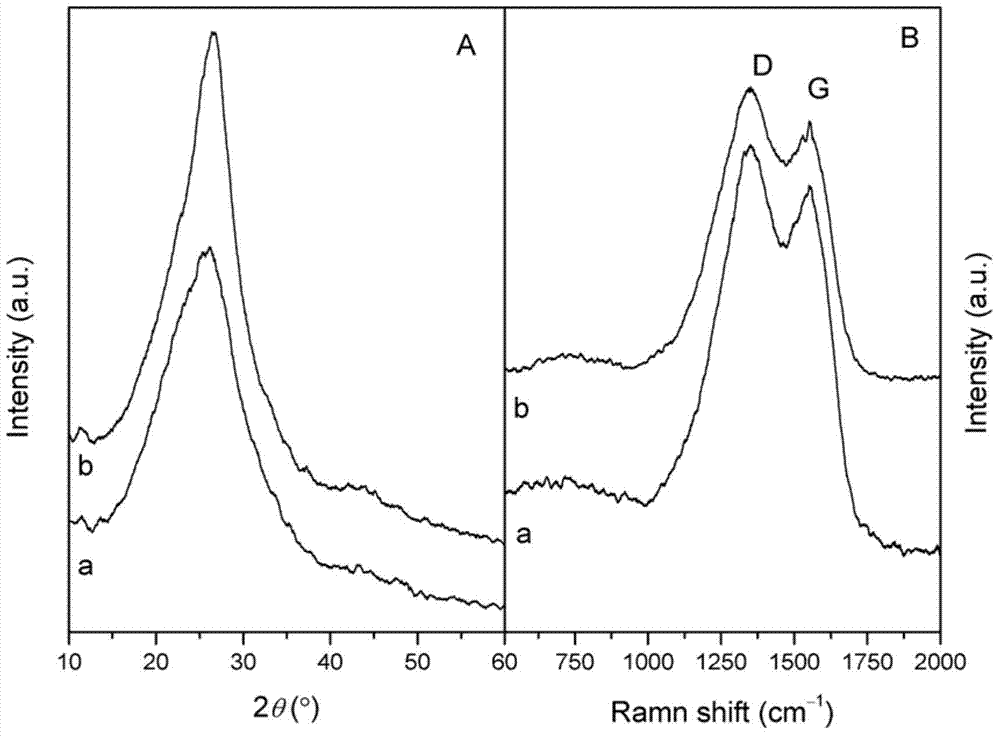Synthetic method of low-cost mesoporous graphite-phase carbon nitride
A technology of graphite phase carbon nitride and synthesis method, which is applied in the direction of nitrogen and non-metallic compounds, can solve problems such as difficult to find solvents, and achieve the effects of wide sources, low price and low toxicity
- Summary
- Abstract
- Description
- Claims
- Application Information
AI Technical Summary
Problems solved by technology
Method used
Image
Examples
Embodiment 1
[0029] (1) Add 1.5 parts by mass of dicyandiamine to 9 parts by mass of ethylenediamine, and stir at room temperature for 5 minutes to obtain a mixed solution of dicyandiamine and ethylenediamine;
[0030] (2) Drop the mixed solution obtained in step (1) into 1 mass part of SBA-15 powder, and stir for 5 minutes to form a transparent semi-fluid, and then age for 4 hours;
[0031] (3) heat the transparent semi-fluid obtained in step 2 in an oil bath at 90°C, and dry overnight to obtain a blocky orange-yellow solid;
[0032] (4) Grinding the orange-yellow solid obtained in step (3) and roasting it in a tube furnace with a nitrogen atmosphere, the heating program conditions are as follows: from room temperature to 2.5 ° C min -1 The heating rate was raised to 550°C, and then kept at this temperature for 4 hours, and a black solid was obtained after cooling down;
[0033] (5) Disperse the black solid obtained in step (4) in 200 parts by mass of 5wt% HF (~4molL -1 ) in aqueous sol...
Embodiment 2
[0038] (1) Add 2.0 parts by mass of dicyandiamine to 9 parts by mass of ethylenediamine, and stir at room temperature for 8 minutes to obtain a mixed solution of dicyandiamine and ethylenediamine;
[0039] (2) Drop the mixed solution obtained in step (1) into 1 mass part of SBA-15 powder, and stir for 8 minutes to form a transparent semi-fluid, and then age for 6 hours;
[0040] (3) heat the transparent semi-fluid obtained in step 2 in an oil bath at 90°C, and dry overnight to obtain a blocky orange-yellow solid;
[0041] (4) Grinding the orange-yellow solid obtained in step (3) and roasting it in a tube furnace with a nitrogen atmosphere, the heating program conditions are as follows: from room temperature to 2.5 ° C min -1 The heating rate was raised to 550°C, and then kept at this temperature for 4 hours, and a black solid was obtained after cooling down;
[0042] (5) the black solid that step (4) obtains is dispersed in the 5wt% NH of 200 mass parts 4 HF 2 (~4mol L -1 ...
Embodiment 3
[0047] (1) Add 2.5 parts by mass of dicyandiamine to 9 parts by mass of ethylenediamine, and stir at room temperature for 12 minutes to obtain a mixed solution of dicyandiamine and ethylenediamine;
[0048] (2) Drop the mixed solution obtained in step (1) into 1 mass part of SBA-15 powder, and stir for 12 minutes to form a transparent semi-fluid, and then age for 6 hours;
[0049] (3) heat the transparent semi-fluid obtained in step 2 in an oil bath at 90°C, and dry overnight to obtain a blocky orange-yellow solid;
[0050] (4) Grinding the orange-yellow solid obtained in step (3) and roasting it in a tube furnace with a nitrogen atmosphere, the heating program conditions are as follows: from room temperature to 2.5 ° C min -1 The heating rate was raised to 550°C, and then kept at this temperature for 4 hours, and a black solid was obtained after cooling down;
[0051] (5) the black solid that step (4) obtains is dispersed in the 5wt% NH of 200 mass parts 4 HF 2 (~4mol L -...
PUM
| Property | Measurement | Unit |
|---|---|---|
| pore size | aaaaa | aaaaa |
| pore size | aaaaa | aaaaa |
| pore size | aaaaa | aaaaa |
Abstract
Description
Claims
Application Information
 Login to View More
Login to View More - R&D
- Intellectual Property
- Life Sciences
- Materials
- Tech Scout
- Unparalleled Data Quality
- Higher Quality Content
- 60% Fewer Hallucinations
Browse by: Latest US Patents, China's latest patents, Technical Efficacy Thesaurus, Application Domain, Technology Topic, Popular Technical Reports.
© 2025 PatSnap. All rights reserved.Legal|Privacy policy|Modern Slavery Act Transparency Statement|Sitemap|About US| Contact US: help@patsnap.com


